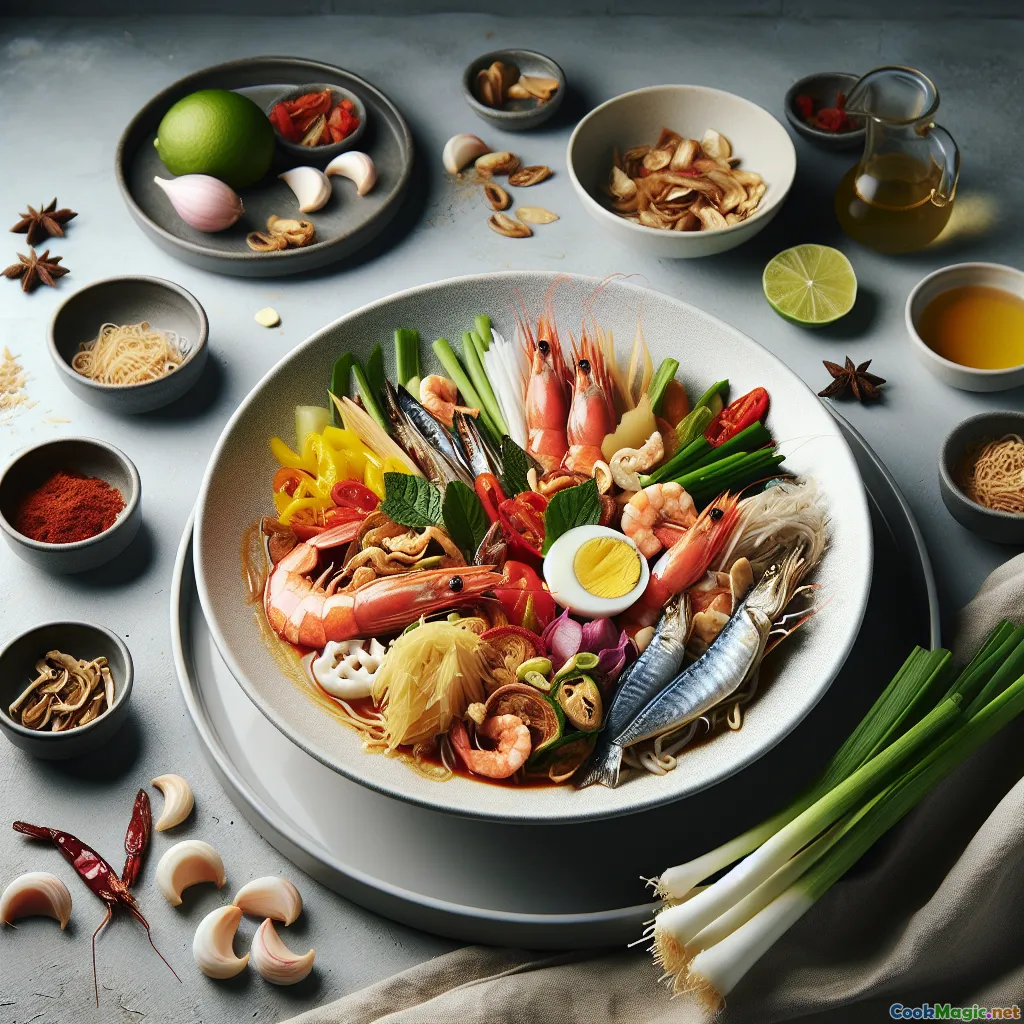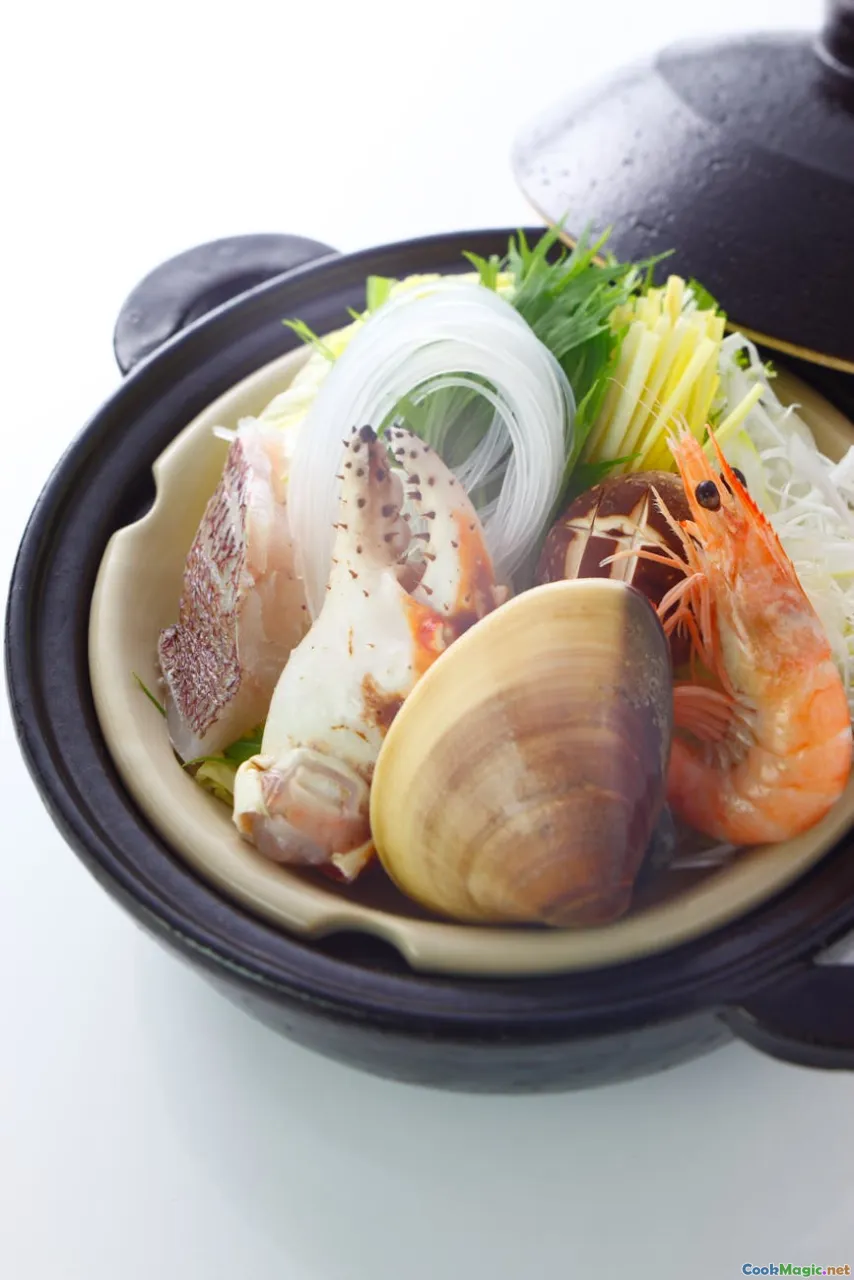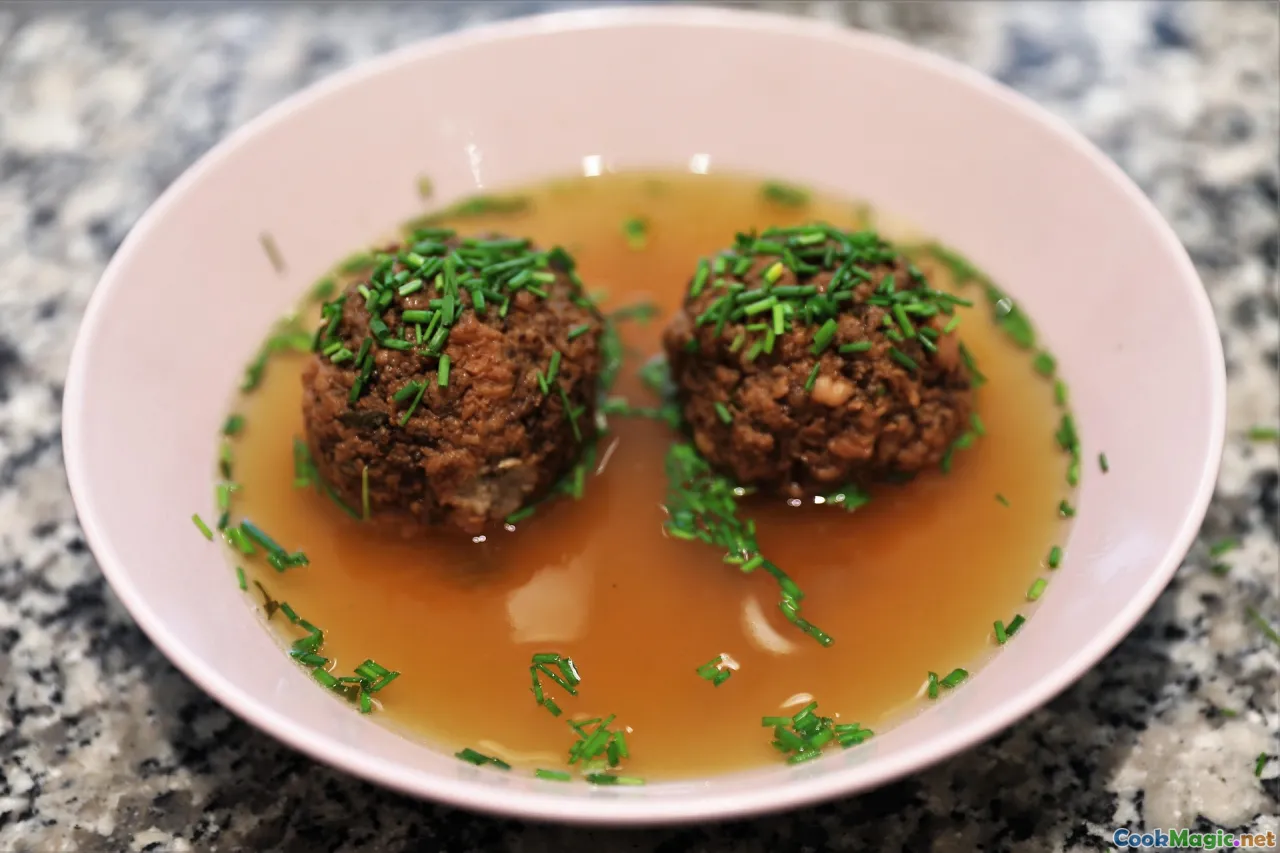
텍완 팔렘방: 새우 육수에 담긴 생선 만두
(Tekwan Palembang: Fish Dumplings in Shrimp Broth)
(0 리뷰)재료
-
300 grams 새우 껍질과 머리
(From the peeled shrimp; forms the broth base)
-
1 tbsp 중성 기름
(For sautéing shells)
-
4 cloves 마늘
(살짝 으깬)
-
10 grams 생강
(얇게 썬)
-
2 stalks 파
(White parts for broth, greens for garnish)
-
1500 ml 물
(Cold water to extract flavor)
-
1 tsp 화이트 페퍼콘
(Whole; adds gentle heat)
-
1 tsp 암석 설탕
(Or granulated sugar; rounds the flavors)
-
2 tsp 소금
(맛에 맞게 조절하세요)
-
1 tbsp 피쉬 소스
(Or light soy sauce for depth)
-
0.25 tsp 글루타민산나트륨
(Optional umami boost)
-
300 grams 스페인 고등어 필레
(Or other firm white fish, skinless & boneless)
-
180 grams 타피오카 전분
(Sago/tapioca for signature bouncy texture)
-
180 ml 얼음 물
(Keep very cold to maintain paste elasticity)
-
1 large 계란 흰자
(Binds and lightens dumplings)
-
1 clove 마늘 페이스트
(곱게 간)
-
0.5 tsp 흰 후추
(간 것)
-
1 tsp 생선 페이스트용 소금
(Seasoning for dumpling mixture)
-
0.5 tsp 생선 페이스트용 설탕
(Balances savoriness)
-
200 grams 껍질 벗긴 새우
(Medium, deveined; shells used for broth)
-
20 grams 건목이버섯
(Soaked until pliable, then thinly sliced)
-
15 grams 건조한 백합 꽃봉오리들
(Soaked and knotted for texture)
-
150 grams 자카마 (bengkuang)
(Julienned for crisp sweetness)
-
100 grams 쌀면
(Soaked until just pliable)
-
20 grams 샐러리 잎
(Indonesian celery if available, chopped)
-
30 grams 튀긴 양파
(시판용 또는 가정에서 만든 것, 토핑용으로.)
-
2 stalks 부추 또는 파의 잎
(얇게 썬)
-
1 whole 라임
(서빙을 위해 조각으로 자르세요)
(From the peeled shrimp; forms the broth base)
(For sautéing shells)
(살짝 으깬)
(얇게 썬)
(White parts for broth, greens for garnish)
(Cold water to extract flavor)
(Whole; adds gentle heat)
(Or granulated sugar; rounds the flavors)
(맛에 맞게 조절하세요)
(Or light soy sauce for depth)
(Optional umami boost)
(Or other firm white fish, skinless & boneless)
(Sago/tapioca for signature bouncy texture)
(Keep very cold to maintain paste elasticity)
(Binds and lightens dumplings)
(곱게 간)
(간 것)
(Seasoning for dumpling mixture)
(Balances savoriness)
(Medium, deveined; shells used for broth)
(Soaked until pliable, then thinly sliced)
(Soaked and knotted for texture)
(Julienned for crisp sweetness)
(Soaked until just pliable)
(Indonesian celery if available, chopped)
(시판용 또는 가정에서 만든 것, 토핑용으로.)
(얇게 썬)
(서빙을 위해 조각으로 자르세요)
영양 정보
- 인분: 4
- 1인분 크기: 1 그릇 (350g)
- Calories: 390 kcal
- Carbohydrates: 55 g
- Protein: 28 g
- Fat: 7 g
- Fiber: 3 g
- Sugar: 4 g
- Sodium: 1100 mg
- Cholesterol: 140 mg
- Calcium: 120 mg
- Iron: 3.1 mg
조리법
-
1 - Soak and prep add-ins:
Soak wood ear mushrooms and lily buds in warm water until pliable (15–20 minutes). Rinse and drain. Soak rice vermicelli in room-temperature water until just flexible. Julienne jicama and chop herbs.
-
2 - Toast shrimp shells:
Heat oil in a pot over medium-high. Add shrimp shells and heads; stir-fry until they turn deep orange and aromatic, pressing with a spatula to release tomalley.
-
3 - Build the broth:
Add garlic, ginger, and white parts of spring onions. Stir 1 minute. Pour in water, add peppercorns, rock sugar, and salt. Bring to a boil, then reduce to a gentle simmer.
-
4 - Simmer and strain:
Simmer uncovered 25–30 minutes, skimming foam. Off heat, stir in fish sauce and MSG if using. Strain the broth, pressing shells to extract maximum flavor. Return clear broth to a clean pot.
-
5 - Make fish paste:
Chill fish briefly. Finely mince or process fish until sticky. In a bowl, beat fish with salt, white pepper, sugar, and garlic paste, drizzling in ice water gradually until glossy and elastic.
-
6 - Add starch and egg white:
Mix tapioca starch and egg white into the fish paste. Beat vigorously with a spatula until the mixture is smooth, cohesive, and slightly tacky (2–3 minutes). Keep cold.
-
7 - Shape and poach dumplings:
Bring the strained broth to a gentle simmer. Scoop small spoonfuls of paste and slide into the broth, or pipe from a bag. Poach until dumplings float and turn opaque, 3–4 minutes.
-
8 - Cook shrimp and mushrooms:
Add peeled shrimp to the simmering broth and cook just until pink, 1–2 minutes. Add sliced wood ear and lily buds; simmer 2 minutes more.
-
9 - Blanch vermicelli and jicama:
Briefly blanch soaked vermicelli in the broth or separate boiling water, 30–45 seconds. Jicama can be added raw for crunch or blanched 15 seconds for a milder bite.
-
10 - Adjust Seasoning:
Taste the broth and adjust salt, white pepper, and fish sauce as needed. Keep the soup at a low simmer to preserve clarity.
-
11 - Assemble Bowls:
Divide vermicelli among bowls. Add dumplings, shrimp, wood ear, lily buds, and jicama. Ladle hot shrimp broth over.
-
12 - Garnish and Serve:
Top with chopped celery leaves, chives/scallion greens, and fried shallots. Serve immediately with lime wedges for brightness.
Soak wood ear mushrooms and lily buds in warm water until pliable (15–20 minutes). Rinse and drain. Soak rice vermicelli in room-temperature water until just flexible. Julienne jicama and chop herbs.
Heat oil in a pot over medium-high. Add shrimp shells and heads; stir-fry until they turn deep orange and aromatic, pressing with a spatula to release tomalley.
Add garlic, ginger, and white parts of spring onions. Stir 1 minute. Pour in water, add peppercorns, rock sugar, and salt. Bring to a boil, then reduce to a gentle simmer.
Simmer uncovered 25–30 minutes, skimming foam. Off heat, stir in fish sauce and MSG if using. Strain the broth, pressing shells to extract maximum flavor. Return clear broth to a clean pot.
Chill fish briefly. Finely mince or process fish until sticky. In a bowl, beat fish with salt, white pepper, sugar, and garlic paste, drizzling in ice water gradually until glossy and elastic.
Mix tapioca starch and egg white into the fish paste. Beat vigorously with a spatula until the mixture is smooth, cohesive, and slightly tacky (2–3 minutes). Keep cold.
Bring the strained broth to a gentle simmer. Scoop small spoonfuls of paste and slide into the broth, or pipe from a bag. Poach until dumplings float and turn opaque, 3–4 minutes.
Add peeled shrimp to the simmering broth and cook just until pink, 1–2 minutes. Add sliced wood ear and lily buds; simmer 2 minutes more.
Briefly blanch soaked vermicelli in the broth or separate boiling water, 30–45 seconds. Jicama can be added raw for crunch or blanched 15 seconds for a milder bite.
Taste the broth and adjust salt, white pepper, and fish sauce as needed. Keep the soup at a low simmer to preserve clarity.
Divide vermicelli among bowls. Add dumplings, shrimp, wood ear, lily buds, and jicama. Ladle hot shrimp broth over.
Top with chopped celery leaves, chives/scallion greens, and fried shallots. Serve immediately with lime wedges for brightness.
텍완 팔렘방: 새우 육수에 담긴 생선 만두 :에 대한 자세한 정보
Tekwan Palembang Kuah Udang: A Bowl of Riverborne Comfort
Tekwan is a beloved specialty from Palembang, the river city of South Sumatra famed for its fish-based delicacies. If you know pempek (fried or boiled fish cakes served with tangy vinegar sauce), consider tekwan its comforting, brothy cousin. In this dish, supple fish dumplings bob in a clear, aromatic shrimp stock and mingle with rice vermicelli, crunchy jicama, wood ear mushrooms, and a shower of herbs and fried shallots. A squeeze of lime brightens the entire bowl. It’s light yet deeply savory—perfect for humid afternoons or as a restorative supper.
What Makes Tekwan Unique
- Bouncy dumplings: The signature texture comes from a finely beaten fish paste and tapioca starch, yielding a tender, springy bite rather than a dense fish ball.
- Clear shrimp broth: Built from toasted shrimp heads and shells, the stock is clean, sweet, and sea-bright without heaviness.
- Crisp-soft contrast: Jicama’s fresh crunch, silky mushrooms, and delicate vermicelli create a harmonious textural spectrum.
- Heritage harmony: Tekwan reflects Palembang’s riverine culture and the influence of Sino-Indonesian kitchens, where lily buds, wood ear, and noodles are common pantry elements.
Ingredient Notes and Smart Substitutions
- Fish: Spanish mackerel is traditional for its sweetness and structure. Substitute wahoo, barramundi, or cod. If using a leaner fish, add a touch more egg white for tenderness.
- Tapioca starch: Essential for the signature bounce. Potato starch works in a pinch, but the texture will be slightly less elastic.
- Broth: Shrimp shells are nonnegotiable for authentic character. If you’re short, bolster with a small piece of dried shrimp (ebi) or a splash of fish sauce.
- Vegetables and fungi: Wood ear brings a gentle crunch; dried lily buds add a subtle floral note. If unavailable, use enoki or thinly sliced shiitake for body.
- Aromatics: White pepper’s gentle warmth suits the clear broth. Fresh ginger lifts and cleans the palate.
Technique Tips for Perfect Dumplings
- Keep it cold: Chill the fish and use ice water. Cold temperature helps proteins bind and creates a springier texture.
- Beat for elasticity: Don’t just mix—beat the paste until it looks glossy and sticky. You’re developing a cohesive protein network.
- Gentle poach: Keep the broth at a bare simmer. A hard boil can roughen dumpling surfaces and cloud the stock.
- Size matters: Small, teaspoon-sized quenelles cook evenly and remain tender.
Clear, Flavorful Broth—Every Time
- Toast the shells: Sautéing shrimp heads and shells coaxes out deep, nutty tones and that coveted orange “tomalley” richness.
- Skim and strain: Skimming foam and straining carefully preserves clarity. Avoid over-agitating the stock once it’s simmering.
- Season in layers: Salt early, then adjust with fish sauce and a dash of sugar at the end to round bitterness without tasting sweet.
Make-Ahead and Storage
- Dumplings: Poach, shock briefly in cool water, then refrigerate up to 2 days. Rewarm gently in broth.
- Broth: Keeps 3–4 days refrigerated or 2 months frozen. Defat after chilling for a pristine finish.
- Components: Store vermicelli and garnishes separately to maintain texture.
Serving and Variations
- Classic garnish: Fried shallots, chopped celery leaves or scallions, and a squeeze of lime.
- Spicy kick: Serve with sambal or fresh bird’s eye chili for heat.
- Deluxe touch: Add a few fish roe dumplings or a handful of blanched bean sprouts for extra crunch.
Cultural Notes
Palembang’s culinary identity is intertwined with waterways feeding into the Musi River. Abundant freshwater and coastal fish inspired a repertoire of fish cakes and soups that travel well and feed communities. Tekwan, often found in home kitchens and modest warung stalls, bridges celebratory and everyday eating: elegant enough for guests, humble enough for weeknights. The addition of wood ear, lily buds, and vermicelli hints at historic trade and cultural mingling with Chinese communities, illustrating how Indonesian cuisines are enriched by movement and exchange.
Troubleshooting
- Dumplings too dense: Increase ice water by a tablespoon, or beat the paste longer. Ensure you didn’t boil aggressively.
- Murky broth: Lower the heat, skim gently, and strain through a fine mesh or cheesecloth.
- Flat flavor: Add a pinch of white pepper, a whisper of sugar, or a small splash of fish sauce. A wedge of lime perks everything up.
Chef’s Note
Tekwan rewards attentiveness more than complexity. With simple ingredients, patience, and good technique, you’ll capture the essence of Palembang in a bowl—clear, clean, and profoundly comforting. Every element has purpose: the buoyant dumplings, the gleaming shrimp broth, the interplay of crunch and silk. Serve it steaming, with lime at the ready, and listen for the quiet satisfaction that follows the first spoonful.




















